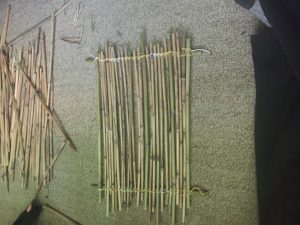(Miscanthus spp.)
Description
Miscanthus is a genus of bunching perennial grasses ranging in size from about a foot up to 3 meters tall. Most are green during the summer, sometimes with white striations, and loose their color during the fall into winter. Some varieties exhibit brilliant red and amber hues in autumn before becoming light brown. Many varieties, such as Miscanthus x giganteus, make strong stalks that, once dried, can be used to build all kinds of things from shelves to bathmats to blinds!
Cultivation Tips
Miscanthus grasses are very easy to grow; perhaps too easy. They can colonize large areas over time with their dense rhizomatic root system, but if divided regularly, they can be easily kept in check. Some propagate by seed, but all can be transplanted from root divisions. They like full sun, but most are not picky about soil type. Most are also very drought resistant as well.
In the winter when the plants are dormant, the previous year’s stalks should be cut down a few inches above the ground to make room for the next years shoots. These can be woven into a living fence, used to make various products, laid down as mulch in pathways and garden beds, or composted.
Echa un vistazo a this video from Edible Acres on miscanthus care and propagation.
Uses
Miscanthus grasses make great additions to a living fence. They help deter animal traffic, and also protect the garden from noise and chemical pollution that comes from roads. Check out this video from our partners at Edible Acres on miscanthus in a living fence.
Miscanthus grasses can be grate for erosion control. Their dense, rhizomatic root system holds the soil together, even on steep slopes.
*picture*
Miscanthus grasses also make excellent habitat for many insects and spiders, helping to build biodiversity and keep populations balanced.
The stalks of miscanthus can be woven into mats or bound into shelves and other furniture items. Making products like these out of miscanthus not only eliminates waste, but sequesters carbon in the form of the dowels and fibers used.
